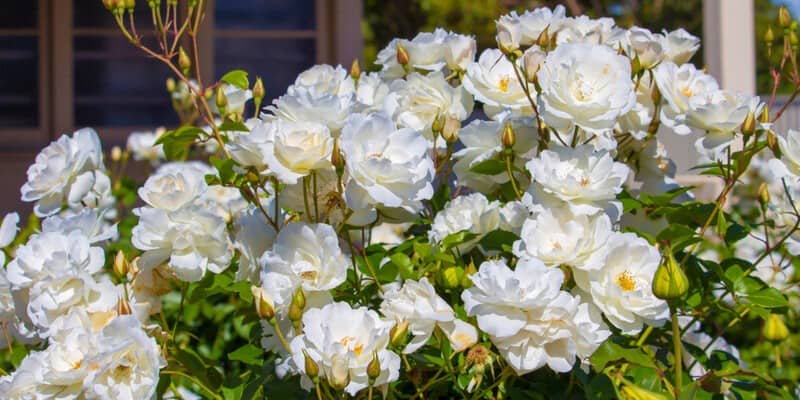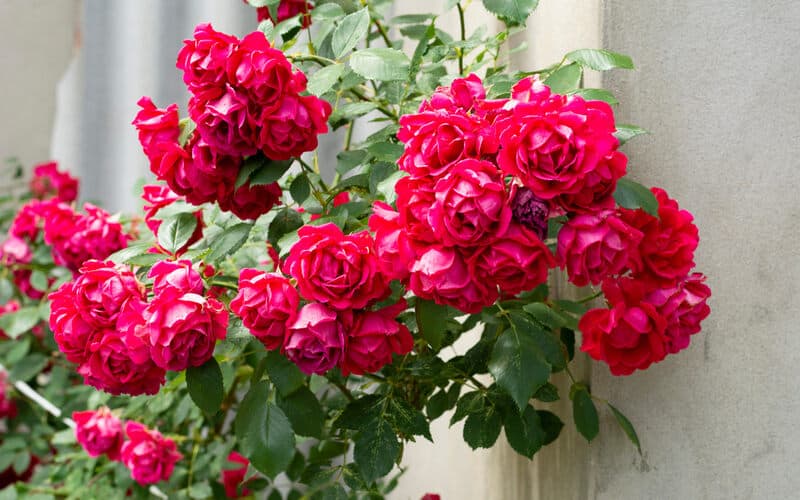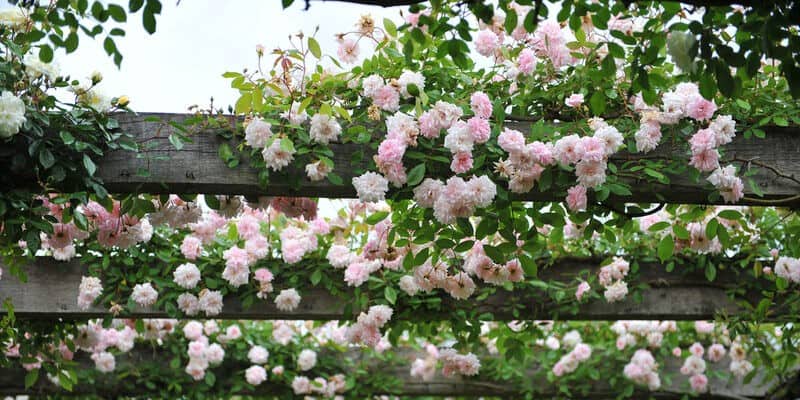Feel like giving your garden an upgrade? Climbing roses are all you need to give your outdoor space a boost. With a few gardening tips and tricks, you’ll have gorgeous rose blooms cascading down your archway or pergola in no time. Our complete guide to climbers and ramblers will show you how.
How to choose the right climbing roses for your garden
David Austin climbing roses are always a forerunner when it comes to choice cultivars, but there are other climbing roses out there that are also worthy of attention. With so many rose varieties to choose from, how do you know which climbing rose is right for your garden? Here are some things to consider:
Colour
Climbing roses come in a dazzling array of colours. From red to white and everything in between, you’re sure to find a cultivar that suits your preference.
Red climbing roses
- ‘Parkdirektor Riggers’
- ‘Etoile de Hollande’
- ‘Guińee’
- ‘Crimson Glory’
White climbing roses
- ‘Claire Austin’
- ‘Iceberg’
- ‘Mme. Alfred Carrière’
- ‘White Cockade’
Pink climbing roses
- ‘Pippin’
- ‘Compassion’
- ‘A Shropshire Lad’
- ‘Gertrude Jekyll’
Yellow climbing roses
- ‘Chris’
- ‘Teasing Georgia’
- ‘Graham Thomas’
- ‘Maigold’
Tip: Make your rose garden extra special by choosing a rose colour that has a unique meaning for you. Read our article on rose colours and their symbolism and to learn more.
Planting site
When picking the best rose variety for your garden, you also have to consider where you’ll place them. Vigorous growers like the ‘Iceberg’ are great as wall covering or over archways. For smaller spaces, go for shorter ramblers. Climbing roses in pots, like ‘Strawberry Hill’, are ornamental and space-saving at the same time.
Blooming season
Climbing roses come in different forms: climbers, ramblers, and pillars. Climbers are usually repeat bloomers and have larger flowers than ramblers.
Ramblers are known to flower only once a year, which they more than compensate for by producing clusters of small-to-medium-sized roses.
Pillar roses have long canes that are attached to a rod or pillar for support. These roses look great as privacy screens when lined up together. As with climbers and ramblers, they also need regular trimming to retain their form.
Ease of maintenance
Climbing roses are easy to grow. They need regular pruning and trimming to keep them in shape, however. If you’re a first-time rose gardener, opt for thornless varieties to make handling your plants easier.
Top 10 Climbing Roses
There are a lot of varieties of climbing roses out there, and all are beautiful in their own right. But which made it to our list of the best climbing roses in Australia? Let’s find out:
- ‘Altissimo’
- ‘American Beauty’
- ‘Cécile Brunner’
- ‘Dublin Bay’
- ‘Fourth of July’
- ‘Iceberg’
- ‘Mme Gregoire Staechelin’
- ‘Peace’
- ‘Royal Sunset’
- ‘Shropshire Lad’
How to grow climbing roses
Most roses are sun-loving plants, and climbing roses are no exception. You’ll find that it’s fairly easy to grow climbing roses in Australia because of the environmental conditions. Pick a planting site where there is plenty of morning sun. This is the best time for your roses to soak in sunlight and dry any moisture from their foliage.
Roses also need plenty of nutrients to boost their leaf and flower production. A loam-rich soil is ideal for planting climbing roses. You can grow roses from cuttings or seed, directly on the ground or in pots. A climbing rose will take 3-5 years to reach its full maturity. By then, your plant will have filled in and have become lush and thick.
Training climbing roses
Walls or fences
Grow climbing roses on walls or fences for a beautiful cascading effect. This can be used to cover unsightly patches or add a dramatic effect to an otherwise lackluster surface.
Step 1. Prepare the structural support
You’ll need a fencing wire for this as well as some screws. Fix the screws onto the wall or fence – this will serve as an anchor for the fencing wire. Make sure that the screws are fastened well and spaced 20cm apart. Stretch the fencing wire over the screws.
Step 2: Train the roses
As soon as you see the main cane grow, bend the cane horizontally. It’s best to do this while the cane is still pliant. Make sure to follow the direction of the wire as you’re training your roses. Varieties with short spurs work best on walls and fences.
Step 3: Prune
Prune after flowering to maintain the shape of your climbing roses. Make sure to prune the side shoots to ensure lush foliage and bloom growth.
Archways or arbours
Climbing roses on archways or arbours makes for a romantic garden setting, and it’s easy to do.
Step 1: Prepare the archway
The first thing you need to check is the size of the archway. Climbing roses can take up space, so be sure that the archway is wide enough that you can walk through easily. We recommend a width of at least 2m.
Step 2: Start training the roses
Start training the roses by placing one rose bush on each side of the archway. Entwine the canes onto the legs of the archway. For best results, use roses of the same variety.
Step 3: Prune
Maintain the shape of your archway by trimming off any old shoots and long stems. Any major pruning, however, should be done after flowering.
How to prune climbing roses
Pruning climbing roses helps them grow into your desired shape and size. A regular prune also helps your plants to flower well and become lush. Leave your climbing rose or rambling rose unpruned, and you’ll end up with a massive mess in your garden!
When pruning, make sure to wear protective clothing and use the right tools. A pair of sharp bypass shears will give your climbers a nice, sharp trim. Remove all dead or sick plant parts when pruning, and cut off small stems that are thinner than a pencil. These weak stems consume your rose’s energy and deplete your plant’s health. Remember to prune at the right time – climbing roses love a major prune right after flowering.
If you’re a first-time rose grower or don’t have the time, it’s best to hire professional pruners and hedge trimmers for this task. It saves you a lot of time and effort, and you can be sure that your roses are handled properly every step of the way.
Want to learn more? Our article on pruning and trimming roses will give you more information about the topic, as well as additional rose gardening tips.
Bonus climbing rose care tips
- Thornless climbing roses are every pruner’s dream. Look into varieties like Smooth Touch. This Australian thornless climbing rose grows well in local soil and weather, and are repeat bloomers.
- When training your roses, use a ribbon instead of twist ties. A nylon ribbon is gentler on the stems, and less damaging than twist ties.
- Angle the stem instead of propping them upright when training your climbing roses. This technique results in more blooms per stem.








